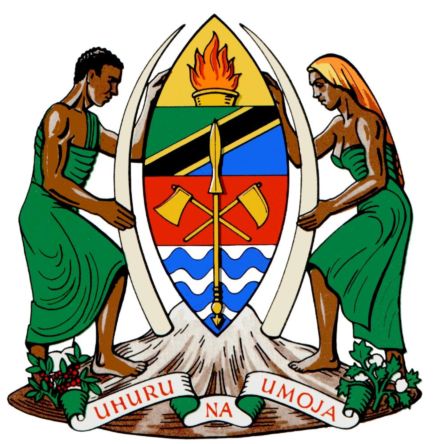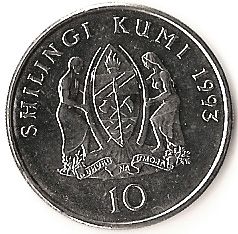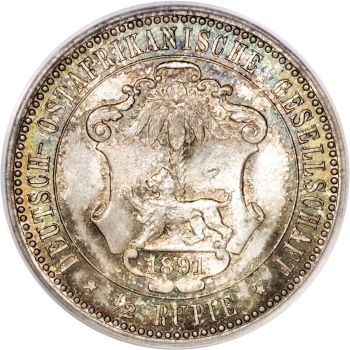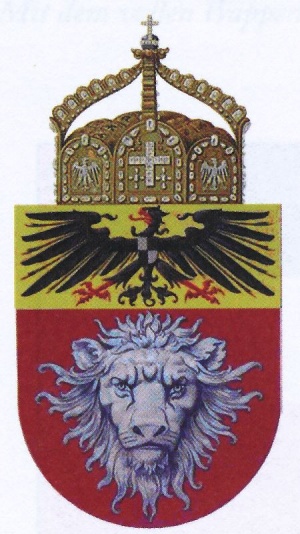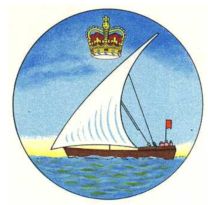National Arms of Tanzania: Difference between revisions
Knorrepoes (talk | contribs) m (Text replacement - "====Origin/meaning====" to "===Origin/meaning===") |
Knorrepoes (talk | contribs) m (Text replacement - "|Arms of {{PAGENAME}}]]" to "|Coat of arms (crest) of {{PAGENAME}}]]") |
||
| (3 intermediate revisions by the same user not shown) | |||
| Line 1: | Line 1: | ||
{ | {{tz}} | ||
'''NATIONAL ARMS OF TANZANIA''' | '''NATIONAL ARMS OF TANZANIA''' | ||
[[File:tanzania.jpg|center| | [[File:tanzania.jpg|center|Coat of arms (crest) of {{PAGENAME}}]] | ||
===Official blazon=== | |||
*'''Arms''': Per fess of four, the first Or, a torch copuped Or, its flame proper; the second of the national flag being parted of Vert and Azure, a bend sinister Sable fimbriated Or. The third Gules; the fourt barry wavy of six Argent and Azure; the three lower parts charged with a spear per pale charged with two axes in saltire Or. | *'''Arms''': Per fess of four, the first Or, a torch copuped Or, its flame proper; the second of the national flag being parted of Vert and Azure, a bend sinister Sable fimbriated Or. The third Gules; the fourt barry wavy of six Argent and Azure; the three lower parts charged with a spear per pale charged with two axes in saltire Or. | ||
*'''Supporters''': Dexter: A tanganyikan man vested Vert, supporting an elephants’ tusk; Sinister a tanganyikan woman, vested Vert, her headscarf orange, supporting an elephants’ tusk | *'''Supporters''': Dexter: A tanganyikan man vested Vert, supporting an elephants’ tusk; Sinister a tanganyikan woman, vested Vert, her headscarf orange, supporting an elephants’ tusk | ||
*'''Compartment''': Mount Kilimanjaro (5,895 m.) between a branch of coffee and a branch of cotton proper. | *'''Compartment''': Mount Kilimanjaro (5,895 m.) between a branch of coffee and a branch of cotton proper. | ||
*'''Motto''': Uhuru na umoja (Liberty and Unity) in red lettering on a white ribbon with green lining. | *'''[[:Category:Mottoes all|Motto]]''': Uhuru na umoja (Liberty and Unity) in red lettering on a white ribbon with green lining. | ||
===Origin/meaning=== | ===Origin/meaning=== | ||
| Line 35: | Line 31: | ||
|align="center"|[[File:tz-c2.jpg|center]] <br/>These arms on a 1891 coin | |align="center"|[[File:tz-c2.jpg|center]] <br/>These arms on a 1891 coin | ||
|- | |- | ||
|align="center"|[[File:ostafrika.jpg|center|300 px| | |align="center"|[[File:ostafrika.jpg|center|300 px|Coat of arms (crest) of {{PAGENAME}}]] <br/>The arms from 1914 | ||
|} | |} | ||
| Line 44: | Line 40: | ||
The new republic adopted new arms, granted on December 6, 1961: | The new republic adopted new arms, granted on December 6, 1961: | ||
[[File:Tanganyika.jpg|center| | [[File:Tanganyika.jpg|center|Coat of arms (crest) of {{PAGENAME}}]] | ||
===Official blazon=== | |||
*'''Arms''': Per fess, the chief per fess, the first Gules and the second of the national flag being Vert, a fess Sable fimbriated Or.; the base barry wavy of six Argent and Azure; and a torch surrounded by four rings Or, the flame proper per pale over all. | *'''Arms''': Per fess, the chief per fess, the first Gules and the second of the national flag being Vert, a fess Sable fimbriated Or.; the base barry wavy of six Argent and Azure; and a torch surrounded by four rings Or, the flame proper per pale over all. | ||
*'''Supporters''': Dexter: A tanganyikan man vested Vert, supporting an elephants’ tusk; Sinister a tanganyikan woman, vested Vert, her headscarf orange, supporting an elephants’ tusk | *'''Supporters''': Dexter: A tanganyikan man vested Vert, supporting an elephants’ tusk; Sinister a tanganyikan woman, vested Vert, her headscarf orange, supporting an elephants’ tusk | ||
*'''Compartment''': Mount Kilimanjaro (5,895 m.) between a branch of coffee and a branch of cotton proper. | *'''Compartment''': Mount Kilimanjaro (5,895 m.) between a branch of coffee and a branch of cotton proper. | ||
*'''Motto''': Uhuru na umoja (Liberty and Unity) in red lettering on a white ribbon with green lining. | *'''[[:Category:Mottoes all|Motto]]''': Uhuru na umoja (Liberty and Unity) in red lettering on a white ribbon with green lining. | ||
These arms were identical in design to the later arms of Tanzania when Tanganyika was joined with Zanzibar to Tanzania in 1964. | These arms were identical in design to the later arms of Tanzania when Tanganyika was joined with Zanzibar to Tanzania in 1964. | ||
Latest revision as of 14:39, 20 August 2023
| Heraldry of the World |
| Tanzania heraldry portal Civic heraldry of Tanzania |
|
NATIONAL ARMS OF TANZANIA
Official blazon
- Arms: Per fess of four, the first Or, a torch copuped Or, its flame proper; the second of the national flag being parted of Vert and Azure, a bend sinister Sable fimbriated Or. The third Gules; the fourt barry wavy of six Argent and Azure; the three lower parts charged with a spear per pale charged with two axes in saltire Or.
- Supporters: Dexter: A tanganyikan man vested Vert, supporting an elephants’ tusk; Sinister a tanganyikan woman, vested Vert, her headscarf orange, supporting an elephants’ tusk
- Compartment: Mount Kilimanjaro (5,895 m.) between a branch of coffee and a branch of cotton proper.
- Motto: Uhuru na umoja (Liberty and Unity) in red lettering on a white ribbon with green lining.
Origin/meaning
The arms were adopted in 1964.
The flame in the upper part symbolises the independence and freedom. Below the flame is the National Flag. The axe and hatchet symbolise the (agricultural) economy and development. The base symbolises the sea. The spear symbolises watchfulness.
The shield, in the local Nguni-style, stands on the Kilimanjaro mountain, the highest in Africa. The two supporters are also hold each an elephant's tusk. The tusks are the traditional symbol of power.
The motto means Freedom and Unity.
| The arms on a coin |
Colonial arms
The area was first colonised by the Deutsch-Ostafrikanische Gesellschaft. In 1891 the mainland area of today's Tanzania was made a German protectorate. The colony did not receive arms until 1914. As the Germans surrendered shortly after the arms were granted, they have (probably) never been used in the colony itself.
| The arms of the Deutsch-Ostafrikanische Gesellschaft |
These arms on a 1891 coin |
| The arms from 1914 |
After the First World War the are became a British protectorate under the name Tanganyika Territory. The territory had no arms.
Tanganyika
Tanganyika became an independent kingdom on 9 December 1961 and Queen Elizabeth II its head of state. The next year the republic was proclaimed on 9 December.
The new republic adopted new arms, granted on December 6, 1961:
Official blazon
- Arms: Per fess, the chief per fess, the first Gules and the second of the national flag being Vert, a fess Sable fimbriated Or.; the base barry wavy of six Argent and Azure; and a torch surrounded by four rings Or, the flame proper per pale over all.
- Supporters: Dexter: A tanganyikan man vested Vert, supporting an elephants’ tusk; Sinister a tanganyikan woman, vested Vert, her headscarf orange, supporting an elephants’ tusk
- Compartment: Mount Kilimanjaro (5,895 m.) between a branch of coffee and a branch of cotton proper.
- Motto: Uhuru na umoja (Liberty and Unity) in red lettering on a white ribbon with green lining.
These arms were identical in design to the later arms of Tanzania when Tanganyika was joined with Zanzibar to Tanzania in 1964.
Zanzibar
The Sultanate and British protectorate of Zanzibar never had its own arms. Under British rule a badge was used:
In 1963 the Sultanate became independent and in 1964 Zanzibar became a republic, which joined Tanganyika later that year.
Today Zanzibar does not uses arms, but the emblem below:
The logo shows the islands of Zanzibar and Pemba between two trees.



